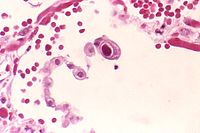
Photo from wikipedia
Objective CMV continues to have a significant impact on HCT despite preemptive antiviral (PET) strategies. Our objective was to assess the incidence and impact of CMV in HCT recipients. Methods… Click to show full abstract
Objective CMV continues to have a significant impact on HCT despite preemptive antiviral (PET) strategies. Our objective was to assess the incidence and impact of CMV in HCT recipients. Methods We performed a retrospective analysis of 1109 seropositive adults who underwent HCT at Stanford University from Jan 2009-May 2019 (Fig. 1). Plasma CMV PCR screening was performed weekly through D+100; from 2009-2012, high risk patients received valganciclovir or ganciclovir. Umbilical cord blood (UCB) recipients received valacyclovir 2000 mg thrice daily. PET was instituted if viral load (VL) was > 400 copies/ml (2009-2012) or >400 IU/ml (2013-2019). CMV disease was defined by published criteria. Results Highlights of our observations: • Despite higher frequency of detectable low-level DNAemia and high-risk transplants, CMV disease has decreased over the last decade (Fig. 2). • Between 2009-2012, 41 patients received CMV prophylaxis (22% VGC 9, 73% GCV, 5% FOS; N=3 received PET; N=1 CMV disease); 53% who did not receive prophylaxis received PET. • Following myeloablative regimens, R+/D- were twice as likely to receive PET, regardless of protocol or donor but were not more likely to develop CMV disease (Table 1a). • ATG group had earlier reactivation (median D+11, range 0-68), higher peak VL and increased incidence of disease (8%). 7% of UCB and haplo who reactivated, did so between D+100-180 (vs 2% ATG). • In 19% of patients only low-grade DNAemia ( • Patients for whom CMV therapy was initiated during a hospitalization had higher median total number of admissions and higher number of inpatient days within the first year (Table 1b). Conclusion Despite PET, CMV continues to have a measurable impact on HCT patients. Other analyses include the significance of low grade VL, area under the curve of DNAemia, peak viremia, transfusion requirements, infections, and relapse.
Journal Title: Biology of Blood and Marrow Transplantation
Year Published: 2020
Link to full text (if available)
Share on Social Media: Sign Up to like & get
recommendations!